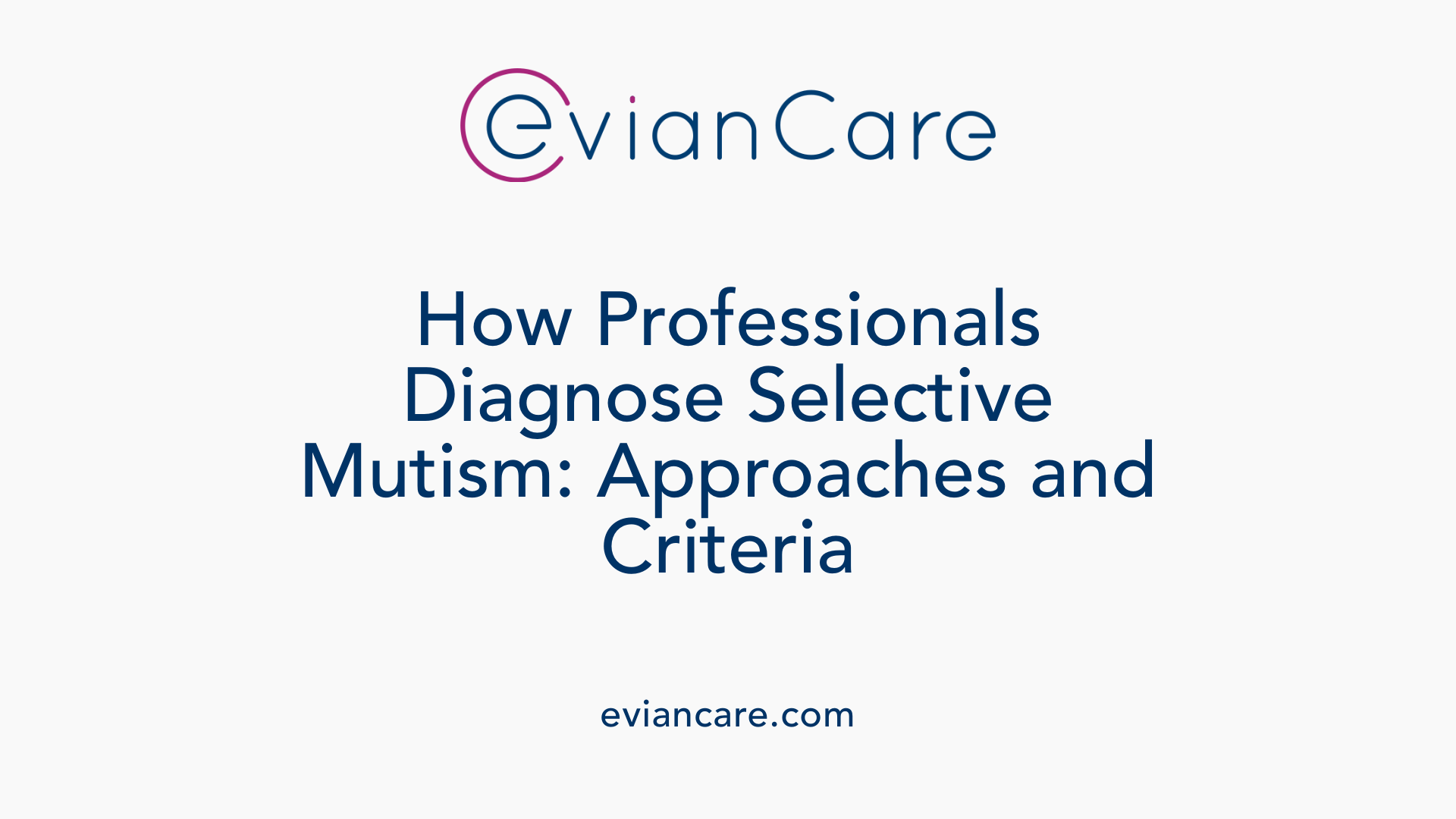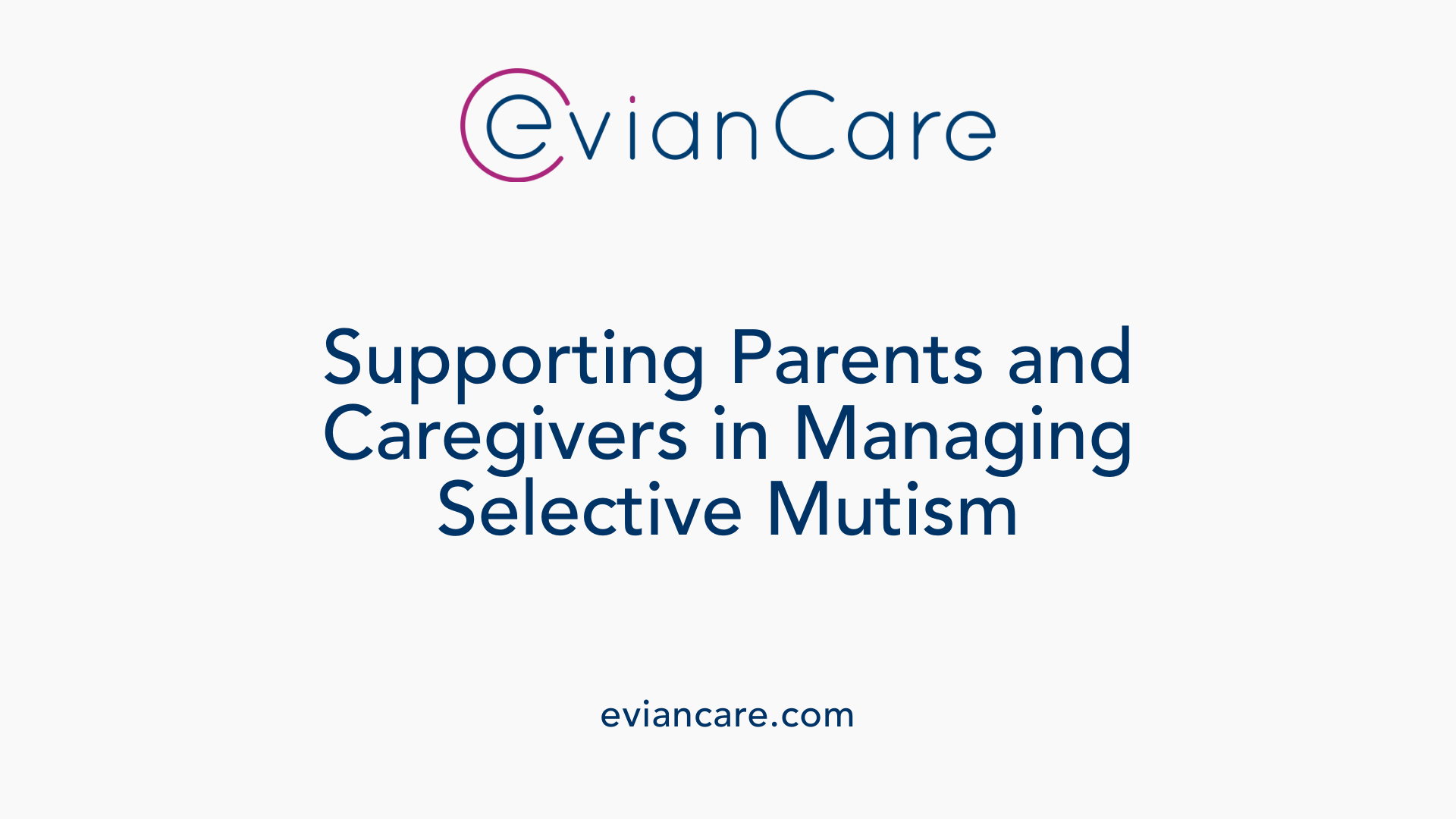
Understanding Selective Mutism in Children
Selective mutism (SM) is a childhood anxiety disorder characterized by a child's consistent inability to speak in certain social situations, like school or public settings, despite being capable of speech at home or in familiar environments. Typically beginning between ages 2 and 6, often around preschool entry, SM can persist for months or even into adulthood without targeted intervention. Children with SM usually show signs of social withdrawal, avoidance behaviors, and physical anxiety symptoms, yet they generally have normal language development overall. Causes are multifaceted, involving genetic predisposition, environmental influences, and co-occurring mental health conditions, but it is distinctly different from communication disorders like autism or stuttering.
Causes and Early Indicators of Selective Mutism

What causes selective mutism in a child?
The exact origins of selective mutism (SM) are not fully clear, but research indicates a complex interplay of genetic, environmental, psychological, and developmental factors.
Genetic and environmental factors play a significant role in the development of SM. Children with a family history of social anxiety or selective mutism are at higher risk, suggesting a hereditary component. Environmental influences such as traumatic experiences, family dynamics, or significant life changes can also trigger or reinforce the condition.
Anxiety disorders, particularly social and separation anxiety, are closely linked to SM. Children experiencing high levels of anxiety in social settings may develop mutism as a response, avoiding speaking to reduce their discomfort.
Developmental considerations include the child's age and developmental stage. SM often begins between ages 2 and 4, coinciding with early social and language development phases. Some children may show signs of extreme shyness or fear of embarrassment, which can be early indicators.
Biological and psychological contributions involve sensory processing issues and co-occurring conditions like autism spectrum disorder. These factors can influence a child's ability to communicate comfortably in certain settings.
In essence, SM arises from a multifaceted combination of genetic predispositions, environmental influences, anxiety-related behaviors, and developmental factors, all contributing to the child's inability to speak in specific social situations.
For more detailed insights, searching "causes of selective mutism in children" can provide extensive information on the subject.
Diagnosing Selective Mutism: Approaches and Criteria

How is selective mutism diagnosed?
Diagnosis of selective mutism is a careful process carried out by mental health or speech-language professionals trained in identifying this specific anxiety disorder. The process begins with gathering a detailed medical, developmental, and behavioral history of the child. Professionals observe the child's speech and communication in different settings, such as at home, school, or in therapy, to identify situations where the child struggles to speak.
Standardized assessment tools are often used. One common questionnaire is the Selective Mutism Questionnaire (SMQ), which helps rate the frequency and situations of mutism. Structured interviews, like the Anxiety Disorders Interview Schedule (ADIS), provide a systematic approach for gathering information from caregivers and teachers.
A key diagnostic criterion is that the child fails to speak in specific social situations, such as at school, despite speaking normally in familiar environments like home. This persists for at least one month, beyond the usual initial adjustment period when children start school.
Importantly, clinicians also rule out other potential causes of speech difficulties, such as autism spectrum disorder, speech or language impairments, or other psychological conditions. They consider reports from parents, teachers, and other caregivers to build a comprehensive picture.
The combination of behavioral observations, standardized tools, and careful differential diagnosis ensures an accurate identification of selective mutism, paving the way for appropriate treatment and support.
Speech Therapy Approaches and Techniques

What are effective speech therapy approaches and techniques for treating selective mutism?
Children with selective mutism benefit from a variety of specialized speech therapy methods that focus on reducing anxiety around speaking and gradually building confidence. Behavioral strategies form the core of many interventions, with techniques like stimulus fading and shaping playing prominent roles.
Stimulus fading involves slowly integrating a child into speaking situations by beginning with less intimidating environments and gradually increasing the complexity or social demands. For example, a child might start by whispering to a familiar person and eventually progress to speaking aloud in a classroom setting.
Shaping techniques reinforce successive approximations of speaking. Initially, the child might be rewarded for any vocalization or gesture, with expectations increasing gradually toward full verbal responses.
Augmented self-modeling, which uses videos of children speaking successfully, helps children visualize positive social interactions, boosting their self-confidence and motivation to communicate.
A structured hierarchy of goals is essential, starting from non-verbal responses to spontaneous speech across different social settings. This hierarchy is customized based on the child's developmental level and anxiety triggers.
Part of effective therapy emphasizes improving social communication and pragmatic language skills—such as taking turns, maintaining eye contact, and verbal exchanges—to support overall social integration.
Close cooperation with caregivers and educators is vital to reinforce positive behaviors across all environments. Therapists often train parents and teachers in techniques like specific praise, patience, and supportive questioning to ensure consistency.
For children with severe identity or anxiety barriers, more intensive behavioral programs might be employed. In some cases, medication prescribed by healthcare providers may be an adjunct to behavioral and speech therapies.
In summary, a combination of behavioral, cognitive, and social communication strategies, delivered consistently within a supportive environment, underpins effective treatment of selective mutism.
Assessment Strategies for Speech-Language Pathologists

How is selective mutism diagnosed?
Assessment conducted by speech-language pathologists (SLPs) involves a comprehensive and collaborative process. A combination of informal observations, formal standardized tests, and detailed reports from caregivers and teachers are utilized to understand the child's communication abilities.
SLPs evaluate speech sound production, language comprehension, and social communication skills across different settings. To reduce stress and encourage participation, they often meet the child before formal assessment, using relaxed, defocused communication strategies. This approach helps gauge genuine abilities and sensitivities.
Part of the assessment also includes examining secondary speech and language issues, such as difficulties with complex sentences, narrative skills, or verbal expression, which may accompany selective mutism.
Integrating information from multiple sources—parents, teachers, psychologists—and conducting observations in naturalistic environments ensures a thorough picture. This team approach guides the development of individualized intervention plans to support both communication skills and anxiety reduction.
Overall, accurate diagnosis hinges on understanding the child's unique speech and language profile, their anxiety triggers, and the contexts where speech is suppressed. Early and precise assessment allows for targeted therapy, increasing the likelihood of successful treatment outcomes.
Treatment Options and Interventions

What treatment options are available for children with selective mutism?
Children with selective mutism benefit from a variety of therapeutic approaches designed to reduce anxiety and gradually improve speech in social settings. Behavioral therapy techniques such as the Ritual Sound Approach® utilize shaping and reinforcement to help children produce speech sounds closer to words, fostering confidence and reducing overcomes.
Cognitive-behavioral therapy (CBT) plays a central role in managing SM by addressing underlying anxiety. CBT often involves graded exposure, where children are systematically introduced to speaking in increasingly challenging environments, paired with positive reinforcement to encourage participation.
In some cases, especially with severe or resistant symptoms, medications like selective serotonin reuptake inhibitors (SSRIs) may be prescribed. These medications are typically used alongside behavioral strategies, particularly when other interventions do not yield sufficient progress.
In addition to direct therapy, involving families and schools is vital. Supportive environments at home and school—where caregivers and educators apply consistent strategies—significantly enhance the child's progress. Techniques such as providing patience, specific praise, and supportive questioning help reinforce therapeutic efforts and promote functional speech.
How do behavioral therapy and CBT work in treating SM?
Behavioral techniques, including stimulus fading—gradually decreasing the distance or difficulty involved in speaking—and shaping, which reinforces small steps toward speaking, are core components. These methods, combined with positive reinforcement, make talking less intimidating.
CBT emphasizes helping children understand and manage their anxiety, often through structured, child-friendly activities that foster a sense of safety and control.
Are there medication considerations?
Medication, mainly SSRIs, may be considered for older children or severe cases, especially when anxiety significantly impairs functioning. Prescribing is overseen by a psychiatrist or pediatrician, and medication use is typically part of a broader treatment plan combining behavioral therapy.
How important is family and school involvement?
Family involvement in therapy includes training parents to implement techniques like gradual exposure and positive reinforcement at home. Schools contribute by creating supportive classroom environments and collaborating with therapists to ensure consistent approaches.
Teamwork among mental health professionals, teachers, and caregivers provides a comprehensive support system, which is crucial for effective treatment and long-term improvement.
| Approach | Methodology | Role in Therapy | Additional Notes |
|---|---|---|---|
| Behavioral Strategies | Stimulus Fading, Shaping, Reinforcement | Gradually increase comfort with speaking in social settings | Often used with gradual exposure techniques |
| Cognitive-Behavioral Therapy (CBT) | Structured, activity-based | Addresses anxiety, teaches self-regulation | Combines with behavioral methods |
| Medication | SSRIs | Reduce significant anxiety symptoms | Used in severe or resistant cases |
| Family and School Involvement | Supportive environments, training | Sustain and reinforce progress, generalize skills | Essential for success |
When interventions are integrated and tailored, children with selective mutism can significantly improve their communication and social skills, easing their anxiety and enhancing participation in everyday activities.
Supporting and Educating Parents and Caregivers

How can parents and caregivers support and educate children with selective mutism?
Parents play a crucial role in helping children with selective mutism (SM) by creating a calm and low-stress environment at home. Using positive reinforcement to celebrate small successes can boost the child's confidence and motivation to speak.
Consistent communication with speech therapists, psychologists, and teachers ensures that everyone works together to reinforce strategies such as gradual exposure to social situations and supportive questioning. This teamwork helps the child feel safe and understood.
Educating teachers and peers about SM is also vital. When others understand that the child's silence is related to anxiety, not disobedience, it fosters patience and empathy. This awareness helps create a supportive social environment where the child feels less pressured.
Parents are encouraged to tailor their responses to the child's comfort level. Using play-based activities and avoiding forcing speech can reduce anxiety and promote natural communication.
Involving caregivers in therapy sessions and providing consistent messages across settings reinforces progress. Patience, understanding, and steady support form the foundation for helping children overcome SM and develop their social communication skills.
Common Myths and Realities About SM and Its Treatments
Are there common myths and misconceptions about selective mutism and its treatment?
Yes, numerous misconceptions surround selective mutism (SM) and the approaches used to treat it. One widespread myth is that children with SM are merely stubborn or disobedient. In truth, their silence is often driven by very high levels of social anxiety, not defiance.
Another common misconception is that SM results from trauma or poor parenting. While environmental factors like family dynamics may play a role, the roots of SM are more complex, involving genetic predispositions, neurological factors, and environmental influences.
Some believe that children with SM are untreatable or will simply grow out of the condition. In reality, evidence shows that behavioral therapies, including gradual exposure and reinforcement strategies, can significantly improve speech development.
It's vital to distinguish SM from other conditions such as autism spectrum disorder or manipulative behaviors. Accurate diagnosis by a trained interdisciplinary team ensures that children receive appropriate interventions tailored to their needs.
Understanding these myths helps families, educators, and professionals to support children with SM effectively and avoid unnecessary frustration or misunderstanding.
Available Resources and Support Programs
Families and professionals seeking assistance for children with selective mutism (SM) have a variety of resources and programs tailored to support communication development and manage anxiety. These include specialized speech and mental health services designed to assess, diagnose, and treat SM through behavioral and therapeutic approaches.
Organizations such as the Selective Mutism Association and the Child Mind Institute provide essential information, guidance, and support for families navigating their child's condition. They offer educational materials, resources for finding qualified therapists, and advice on effective intervention strategies.
One notable program is Brave Buddies, an intensive group therapy designed specifically for children with SM. This program emphasizes real-world applications, social exposure, and supportive techniques to foster verbal communication in social settings.
Online platforms and educational materials also play a crucial role. Webinars, scholarly articles, and digital resources help families, educators, and clinicians stay updated on the latest research and effective treatments. Programs often incorporate techniques such as stimulus fading, shaping, and self-modeling, which have shown promising results.
Support tools extend beyond therapy, including patience, positive reinforcement, and tailored strategies to create a supportive environment both at home and in school. For multilingual children, resources help differentiate between language acquisition challenges and SM to ensure accurate diagnosis and appropriate support.
Legal rights and accommodations are also part of the broader support system, helping families advocate for their children's needs in educational settings. Overall, a comprehensive approach combining therapy, community support, educational resources, and advocacy provides the best pathway to helping children with SM thrive.
Setting Treatment Goals and Measuring Success
What are measurable treatment goals for children with selective mutism?
Achieving progress in treating children with selective mutism involves setting clear, practical objectives that can be tracked over time. These goals are often structured around the SMART system—making them Specific, Achievable, Relevant, Time-bound, and Observable.
For example, initial goals might include a child responding verbally to simple greetings within a designated timeframe during therapy sessions or at school. As confidence builds, goals evolve to include initiating conversations with peers or teachers, participating in classroom discussions, or engaging in group activities.
The progression typically moves from nonverbal responses—like nodding or gesturing—to spontaneous verbal speech in various social settings. These objectives are tailored to each child's developmental level and comfort zone.
Regular assessment plays a crucial role in monitoring progress. Input from caregivers, teachers, and speech therapists helps determine if the goals are being met. Tracking can involve checklists, observation notes, and structured assessments.
Focusing on reducing anxiety and fostering comfort across different settings remains central. Success is marked by achieving incremental milestones such as increased spontaneous speech, decreased hesitation, and greater social participation.
Overall, setting measurable goals based on the child's individual needs and consistently evaluating them helps create a structured pathway toward overcoming selective mutism.
Fostering Communication and Social Confidence
Effective speech therapy for children with selective mutism combines behavioral strategies, social communication training, and supportive environments created by families and educators. Recognizing the multifaceted nature of SM and differentiating it from other conditions ensures appropriate intervention. Early diagnosis and comprehensive, team-based treatment approaches—incorporating therapy, parental support, and educational accommodations—can significantly improve outcomes, helping children develop confidence and thrive socially and academically.












